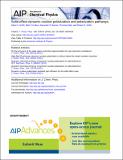| dc.contributor.author | Corzilius, Bjorn | |
| dc.contributor.author | Smith, Albert Andrew | |
| dc.contributor.author | Barnes, Alexander | |
| dc.contributor.author | Maly, Thorsten | |
| dc.contributor.author | Griffin, Robert Guy | |
| dc.date.accessioned | 2012-11-06T15:26:52Z | |
| dc.date.available | 2012-11-06T15:26:52Z | |
| dc.date.issued | 2012-01 | |
| dc.date.submitted | 2011-05 | |
| dc.identifier.issn | 0021-9606 | |
| dc.identifier.issn | 1089-7690 | |
| dc.identifier.uri | http://hdl.handle.net/1721.1/74569 | |
| dc.description.abstract | Using dynamic nuclear polarization (DNP)/nuclear magnetic resonance instrumentation that utilizes a microwave cavity and a balanced rf circuit, we observe a solid effect DNP enhancement of 94 at 5 T and 80 K using trityl radical as the polarizing agent. Because the buildup rate of the solid effect increases with microwave field strength, we obtain a sensitivity gain of 128. The data suggest that higher microwave field strengths would lead to further improvements in sensitivity. In addition, the observation of microwave field dependent enhancements permits us to draw conclusions about the path that polarization takes during the DNP process. By measuring the time constant for the polarization buildup and enhancement as a function of the microwave field strength, we are able to compare models of polarization transfer, and show that the major contribution to the bulk polarization arises via direct transfer from electrons, rather than transferring first to nearby nuclei and then transferring to bulk nuclei in a slow diffusion step. In addition, the model predicts that nuclei near the electron receive polarization that can relax, decrease the electron polarization, and attenuate the DNP enhancement. The magnitude of this effect depends on the number of near nuclei participating in the polarization transfer, hence the size of the diffusion barrier, their T[subscript 1], and the transfer rate. Approaches to optimizing the DNP enhancement are discussed. | en_US |
| dc.description.sponsorship | National Institutes of Health (U.S.) (Grant EB002804) | en_US |
| dc.description.sponsorship | National Institutes of Health (U.S.) (Grant EB002026) | en_US |
| dc.language.iso | en_US | |
| dc.publisher | American Institute of Physics (AIP) | en_US |
| dc.relation.isversionof | http://dx.doi.org/ 10.1063/1.3670019 | en_US |
| dc.rights | Article is made available in accordance with the publisher's policy and may be subject to US copyright law. Please refer to the publisher's site for terms of use. | en_US |
| dc.source | Prof. Griffin via Erja Kajosalo | en_US |
| dc.title | Solid effect dynamic nuclear polarization and polarization pathways | en_US |
| dc.type | Article | en_US |
| dc.identifier.citation | Smith, Albert A. et al. “Solid Effect Dynamic Nuclear Polarization and Polarization Pathways.” The Journal of Chemical Physics 136.1 (2012): 015101. © 2012 American Institute of Physics | en_US |
| dc.contributor.department | Massachusetts Institute of Technology. Department of Chemistry | en_US |
| dc.contributor.approver | Griffin, Robert G. | |
| dc.contributor.mitauthor | Corzilius, Bjorn | |
| dc.contributor.mitauthor | Smith, Albert Andrew | |
| dc.contributor.mitauthor | Barnes, Alexander | |
| dc.contributor.mitauthor | Maly, Thorsten | |
| dc.contributor.mitauthor | Griffin, Robert Guy | |
| dc.relation.journal | Journal of Chemical Physics | en_US |
| dc.eprint.version | Final published version | en_US |
| dc.type.uri | http://purl.org/eprint/type/JournalArticle | en_US |
| eprint.status | http://purl.org/eprint/status/PeerReviewed | en_US |
| dspace.orderedauthors | Smith, Albert A.; Corzilius, Björn; Barnes, Alexander B.; Maly, Thorsten; Griffin, Robert G. | en |
| dc.identifier.orcid | https://orcid.org/0000-0003-1589-832X | |
| mit.license | PUBLISHER_POLICY | en_US |
| mit.metadata.status | Complete | |
